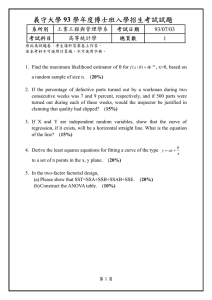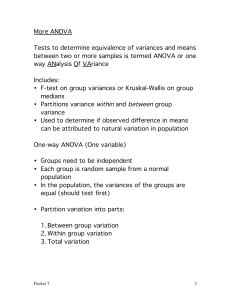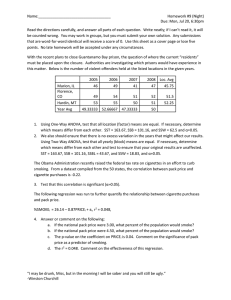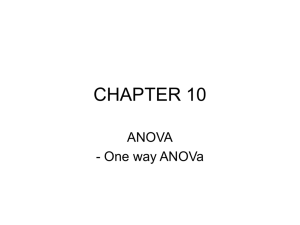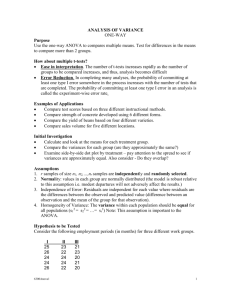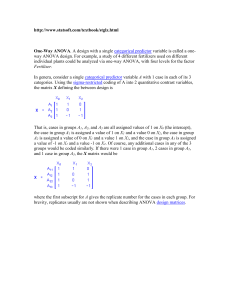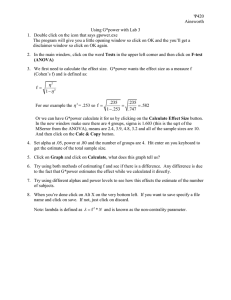Chapter 10 Hypothesis Testing III (ANOVA)
advertisement
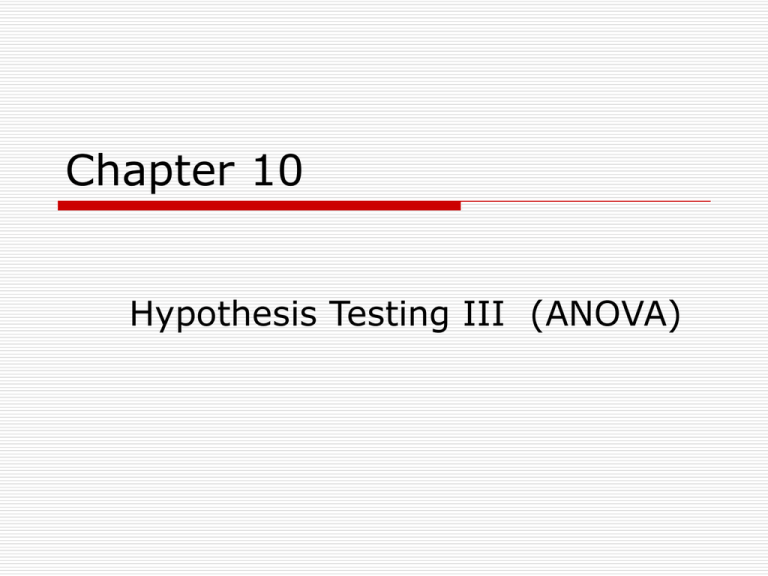
Chapter 10 Hypothesis Testing III (ANOVA) Basic Logic ANOVA can be used in situations where the researcher is interested in the differences in sample means across three or more categories. Basic Logic Examples: How do Protestants, Catholics and Jews vary in terms of number of children? How do Republicans, Democrats, and Independents vary in terms of income? How do older, middle-aged, and younger people vary in terms of frequency of church attendance? Basic Logic ANOVA asks “are the differences between the sample means so large that we can conclude that the populations represented by the samples are different?” The H0 is that the population means are the same: H0: μ1= μ2= μ3 = … = μk Basic Logic If the H0 is true, the sample means should be about the same value. If the H0 is false, there should be substantial differences between categories, combined with relatively little difference within categories. The sample standard deviations should be low in value. Basic Logic If the H0 is true, there will be little difference between sample means. If the H0 is false, there will be big difference between sample means combined with small values for s. Basic Logic The larger the differences between the sample means, the more likely the H0 is false.-- especially when there is little difference within categories. When we reject the H0, we are saying there are differences between the populations represented by the sample. Steps in Com putation of ANOVA 1. Find SST by Formula 10.10. 2. Find SSB by Formula 10.4. 3. Find SSW by subtraction (Formula 10.11). Steps in Computation of ANOVA 4. Calculate the degrees of freedom (Formulas 0.5 and 10.6). 5. Construct the mean square estimates by dividing SSB and SSW by their degrees of freedom. (Formulas 10.7 and 10.8). 6. Find F ratio by Formula 10.9. Example of Computation of ANOVA Problem 10.6 Does voter turnout vary by type of election? Data are presented for local, state, and national elections. Example of Computation of ANOVA ∑X ∑X2 Group Mean Local State National 441 559 723 20,213 27,607 45,253 36.75 46.58 60.25 Example of Computation of ANOVA The difference in the means suggests that turnout does vary by type of election. Turnout seems to increase as the scope of the election increases. Are these differences significant? Example of Computation of ANOVA Use Formula 10.10 to find SST.2 SST X NX 2 Use Formula 10.4 to find SSB 2 SST 93073 36 47.86 Find SSW by subtraction SST 93073 (82460.87) SSW = SST – SSB SSW = 10,612.13 - 3,342.99 SST 10612.13 SSW= 7269.14 Use Formulas 10.5 and 10.6 to calculate degrees of freedom. Example of Computation of ANOVA Use Formulas 10.7 and 10.8 to find the Mean Square Estimates: MSW = SSW/dfw MSW =7269.14/33 MSW = 220.28 MSB = SSB/dfb MSB = 3342.99/2 MSB = 1671.50 Example of Computation of ANOVA Find the F ratio by Formula 10.9: F = MSB/MSW F = 1671.95/220.28 F = 7.59 Step 1 Make Assumptions and Meet Test Requirements Independent Random Samples LOM is I-R The dependent variable (e.g., voter turnout) should be I-R to justify computation of the mean. ANOVA is often used with ordinal variables with wide ranges. Populations are normally distributed. Population variances are equal. Step 2 State the Null Hypothesis H0: μ1 = μ2= μ3 The H0 states that the population means are the same. H1: At least one population mean is different. If we reject the H0, the test does not specify which population mean is different from the others. Step 3 Select the S.D. and Determine the C.R. Sampling Distribution = F distribution Alpha = 0.05 dfw = (N – k) = 33 dfb = k – 1 = 2 F(critical) = 3.32 The exact dfw (33) is not in the table but dfw = 30 and dfw = 40 are. Choose the larger F ratio as F critical. Step 4 Calculate the Test Statistic F (obtained) = 7.59 Step 5 Making a Decision and Interpreting the Test Results F (obtained) = 7.59 F (critical) = 3.32 The test statistic is in the critical region. Reject the H0. Voter turnout varies significantly by type of election.
